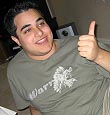|
|
 
|
|
Author
|
Topic: Superimposing 2 Data Projector Images
|
|
|
Matthew Nock
Film Handler

Posts: 82
From: Bairnsdale, Victoria, Australia
Registered: Jan 2003
|
 posted 10-19-2003 10:28 AM
posted 10-19-2003 10:28 AM




Hi Matthew,
the Panasonic LT-6xxx series projector we are using in our largerst screen for Video Advertising talks about doing exactly what you are doing, using two projectors for making the image brighter.
Unfortunately, they make it sound very simple! (they describe it in a paragraph).
If both projectors are exactly the same, I would talk to the manufacturer, and see if they have a process (the panasonic units have a bracket, and an interconnect cable I beleive).
This should then allow them both to work as one, well thats what I understand from the jinglish manual that we have.
Cheers,
Matt
| IP: Logged
|
|
|
|
|
|
Paul Mayer
Oh get out of it Melvin, before it pulls you under!

Posts: 3836
From: Albuquerque, NM
Registered: Feb 2000
|
 posted 10-19-2003 01:54 PM
posted 10-19-2003 01:54 PM





A half hour is not bad for doing a good overlay. Some of the things I do to make things go faster when setting up to do one:
- Ensure both machines are level to each other--I bubble level both machines for front-back and side-side tilt as a starting point. Use of a stacker can help here.
- Ensure both machines' projection axes are parallel--no physical toe-in, at least as a starting point. Again, use of a stacker can help here.
- Obviously you want the same lens in both machines.
- Ensure that any electronic keystone, linearity, or skew correction is dialed out as a starting point.
- I also zero out any previous picture adjustments (gains, black levels, chroma levels and phase, clock phase).
- I especially zero out sharpness. On most machines any added sharpness greatly mucks up the quality of the edges of vertical lines, making it tougher to see when you've got a good overlay.
With the machines physically positioned this way, most of the mechanical part of doing an overlay will be straightforward, i.e. size, centering (H/V lens shift/H timing), and focus should be all you need. One should try to position the machines such that little or no electronic keystone correction will be needed. Many machines introduce visible moire to the image once the image pixel array no longer maps to the imager pixal array. Also one may need to touch up H/V linearity or skew (rotation) on one machine in order to achieve perfect alignment. Linearity and skew, if available at all, are not usually available on user menus--you may have to access a service menu to get to it.
As for geometry patterns, I use a center cross to start, then switch to a circle hatch. The cross lets you get the basics of size, centering, and focus. The circle hatch lets you evaluate overall geometry (H/V linearity and/or skew) and corner quality.
I also bring along a piece of cardboard to quickly douse one machine--by rapidly flagging one machine you can see small overlay errors pretty easily. This also works for comparing picture adjustments.
That's it for overlay and geometry--the rest is picture adjustments.
I set picture black and white levels next, using a needle pulse or white window for the white level, and a pluge with APL for the black level. Obviously the room lighting must be set before doing this. The SMPTE bar pattern will work for this in a pinch.
I take a quick look at grey scale using a chip chart only to see if there are any really gross RGB mistrackings going on--ideally all of the chips should look neutral grey. If things are really ugly you could try to adjust RGB gains and blacks by eye to get close. To do a real grey scale you have to have a 6500K reference and a color temperature meter and more than likely a lot of time.
Next I look at chroma level (and phase if using an NTSC source) using SMPTE bars. The reverse color chips make setting chroma level (and phase) very easy compared to the old EIA bars.
Finally I look at the actual show pictures and check sharpness level. I try to use as little sharpness as possible, since most sharpness circuits are really noise generators and enhancers, fattening up vertical edges and adding ringing to the picture.
Here's some frame grabs from the Avia and Video Essentials DVDs. Note that in the actual cross and hatch patterns the H and V lines will all be the same width and amplitude--the variances you see here are from JPEGing these frame grabs for posting here:
100IRE center cross (Avia):

100IRE circle hatch (Avia):

Needle pulse plus PLUGE (Avia):

PLUGE with low APL (VE):

PLUGE with high APL (VE):

Grey scale (Avia):

SMPTE bars (VE):

| IP: Logged
|
|
|
|
All times are Central (GMT -6:00)
|
|
Powered by Infopop Corporation
UBB.classicTM
6.3.1.2
The Film-Tech Forums are designed for various members related to the cinema industry to express their opinions, viewpoints and testimonials on various products, services and events based upon speculation, personal knowledge and factual information through use, therefore all views represented here allow no liability upon the publishers of this web site and the owners of said views assume no liability for any ill will resulting from these postings. The posts made here are for educational as well as entertainment purposes and as such anyone viewing this portion of the website must accept these views as statements of the author of that opinion
and agrees to release the authors from any and all liability.
|

 Home
Home
 Products
Products
 Store
Store
 Forum
Forum
 Warehouse
Warehouse
 Contact Us
Contact Us




 Printer-friendly view of this topic
Printer-friendly view of this topic






![[thumbsup]](graemlins/thumbsup.gif)








